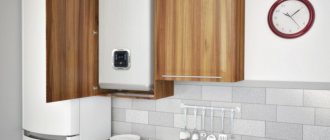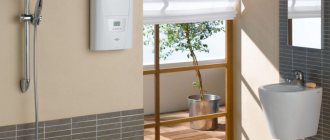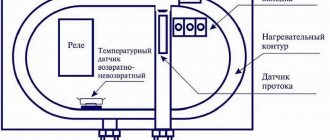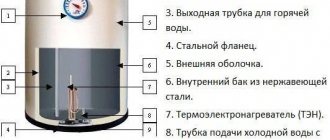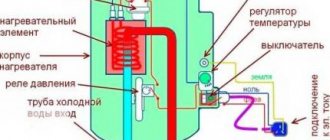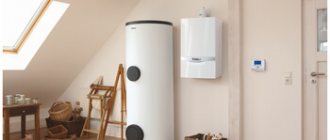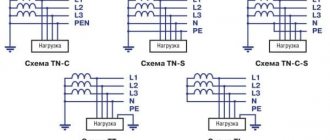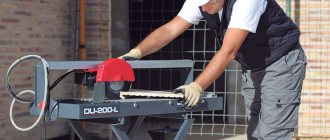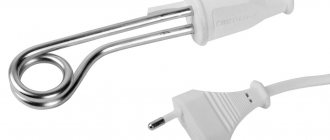The difference between instantaneous water heaters and storage water heaters
The difference is immediately obvious from the name - water flows or accumulates. The pros and cons (or differences) of these two types of water heaters are listed below.
Characteristics of electric water heaters
- Dimensions and weight of the heater. The flow-through type has much smaller dimensions; it can be hidden under the sink or, for example, in a cabinet nearby; its weight is about 1 kg. The storage tank is a large tank with a capacity of about 200 liters, and accordingly its weight in the “charged” state is more than 200 kg. Storage water heaters with a capacity of more than 200 liters are usually installed in a floor-standing version.
- Power consumption. This parameter is very important from an electrical point of view; much attention will be paid to it later in the article. For a flow-through heater it is very large, and can be comparable to the power consumed by the entire apartment - 7 kW and above. The storage heater consumes less electricity - 1.5...3 kW
- Water heating speed. The main advantage of an instantaneous water heater is the speed of operation. He opened the faucet - and after a couple of seconds, “it was warm.” The storage one heats the entire volume at once, and it may take up to an hour to heat the water to normal temperature.
- Price. Here the difference is noticeable, for flow-through the price is 1500-2000 rubles, the price of accumulative ones is 2-3 times higher. A “normal” storage water heater starts at a price of 6000, but again, everything greatly depends on the desired parameters.
- I would also divide flow-through ones into 2 groups based on design . There are those that simply have an outlet for a half-inch pipe (hose), and then you can connect it wherever you want. And there are those whose design includes a tap or hose with a shower.
How to install a water heater on drywall in 20 minutes after a bathroom renovation
If necessary, plates from any sufficiently strong sheet material are used.
Flow sensor or its mechanical equivalent This element supplies power to the heater at the moment when water movement is detected.
But even in this case, it is not recommended to simultaneously turn on several household electrical appliances at once, so as not to knock out the fuse plugs on the electrical panel or, even worse, to avoid a short circuit.
I call a heat exchanger a unit in which water is heated; usually a heating element is installed in it. If the seller offers installation services, consider this option, especially when purchasing an electric pressure model or a geyser. The advantage of the device is that it instantly heats running water in the tap or for the shower.
Storage water heaters, unlike instantaneous water heaters, have a thermally insulated storage tank of 5 to liters for water, where it is constantly heated - maintaining the water temperature you set. It must be remembered that in this case the light bulb does not reflect the operation of the heating element - if it burns out, it will also glow, but heating will not occur. Installation of metal-plastic systems The use of an aluminum layer in the wall of a water pipe for both cold and hot water is caused by the need to protect the metal parts of the system from oxidation.
Watch the video Watch the video Connecting the water heater to the power supply There is an opinion among consumers that connecting the water heater to the power supply consists of plugging the plug into the socket. If the pressure in the system is less than permissible, the electricity is turned off and the indicator goes off. Thermex water heater power relay Now it’s worth considering the control system for the contact group of the relay P, which is controlled by the coil current. Design solutions can use different power supply connections.
Article Video An electric instantaneous water heater is most often used if problems with the supply of hot water in the apartment are common. Electronic control allows the use of an instantaneous electric water heater with several water dispensing points. Owners of private houses who do not have the opportunity to connect to systems with main gas will have to give preference to electric options for equipment that prepares sanitary water.
As a result, the energy consumption is the same. The power of such devices is usually kW. Electronically controlled instantaneous water heaters come in two types: models with only water temperature control; models with adjustable temperature and liquid pressure. Drawing of a dry heating element. Instantaneous water heater repair
Which water heater to choose - storage or instantaneous?
If you decide to approach the issue of heating water thoroughly, then it is better to go to the expense and choose storage water heater (links at the beginning of the article).
We planned to go swimming and wash the dishes in an hour - we turned it on, washed and shaved, and turned it off. And the water will cool for a long time (several hours), it can be used without consuming electricity.
If you need hot water here and now, or are limited in funds, or have nowhere to put this huge tank, then, of course, it is better to choose a compact, instantaneous water heater. But here you need to take a special approach to the power supply, which will be discussed below.
Diagram and design of an instantaneous water heater
The electrical circuit diagram of the Termex System instantaneous water heater is shown below. The diagram is taken from the instructions, which can be downloaded at the end of the article.
Scheme of instantaneous water heater Termex System
So, what’s “under the hood” of this water heater and how does its electrical circuit work?
- M is a flow sensor that closes its contacts as soon as there is sufficient water flow. That is, if the water flows weakly or there is none at all, it will not turn on and the circuit will not work.
- P - power control relay, switched on by the flow sensor M. This relay turns on the power to the heating elements with its contacts.
- T1 – temperature sensor, T2 – temperature sensor with mechanical activation, used to prevent overheating of the heating elements. If these sensors are triggered, the heating elements will no longer turn on. If sensor T2 is triggered, it can be turned on manually after cooling.
- TEN1, TEN2 – electric heating elements, in this device they turn on simultaneously.
- N - neon indicator on the front panel.
- L – Phase, Line
- N – Zero, Neutral
- E - Earth
Let's look at the photo of a real flow-through water heater:
Instantaneous water heater Termex System - device and principle of operation
As you can see, there is only one overheating sensor (T1, it has one contact through which both heating elements are powered). The manufacturer warns in the instructions that it can change the layout and design at its discretion.
The photo does not show how the two heating elements are powered separately.
Instantaneous water heater Termex System - a closer look at the device
Here the arrow shows the button (Reset), which must be pressed if the overheating sensor is triggered.
And here is a photo showing the relay parameters:
Relay turning on heating elements
Overview characteristics of flow-through heaters
Elecrolux Smartfix 2.0 S is a flow-through heater of a non-pressure type, for powering one point of analysis. A copper heating element with a power of 3.5 kW provides a productivity of 2 l/min, which is quite enough to meet the necessary needs for hot water. The control system operates on a hydraulic principle, and it is possible to use 3 power modes. Excessive heating is controlled by temperature sensors. Connecting to water supply and electricity is quite simple, although it requires qualified personnel.
Video:
Thermex Stream 500 is a fairly compact heater, equipped with leads for connecting a faucet and a shower head, which allows for universal use of the device. A maximum power of 5 kW and a productivity of 3.8 l/min will provide hot water to an apartment or small country house. A special feature of the model is the ability to use two operating modes when heating, which will help save energy and reduce the load on the network. The heat sensor prevents overheating of the housing parts, and the pressure switch will prevent the heater from turning on in the absence of water. The tubular heating element has a ceramic filling, which, together with a copper flask, can increase the service life of the device. Operation control is carried out through indicators and buttons on the front surface.
Video:
AEG RMC 75 is a pressure-type heater with a power of 7.5 kW, which allows you to provide several points of hot water with a temperature of up to 60 degrees with a productivity of l/min. The device is simply installed in the water supply system and does not require fundamental changes in the electrical network. The use of innovative control on microcircuits allows for precise adjustment of the temperature of the leaving water depending on the pressure. The control unit remains operational even during long-term operation, due to the cooling of the housing by the incoming cold flow. The use of two heating elements, together with copper flasks, can significantly increase the service life of the device. In addition to the temperature regulator, a heating limiter is built into the heater design. Control of the device is quite simple - the approximate temperature parameter is manually set, and the rest of the functions are taken over by the automation.
Video:
Thermex System 800 is a heater with a fully automated operating cycle, pressure type. The power of the device is 8 kW, while the productivity is 6 l/min. Such parameters allow you to provide several points of hot water supply. The small dimensions of the device allow for installation in various options. The flow is heated by elements located in copper housings supplemented with ceramic filler. This solution reduces the occurrence of corrosion on flow and heating elements. Temperature parameters are regulated by sensors and relays, which allow you to achieve the most comfortable parameters. The plastic body is highly durable and looks stylish in any interior.
https://youtube.com/watch?v=FK9LxIphWw0
Video:
Bosch ED12-2S is a pressure flow heater designed to provide fairly large hot water needs for a large apartment or cottage. The power of the device is quite high - 12 kW, but this is compensated by high productivity - 7.5 l/min, during long-term operation. High reliability of the device is ensured by the operation of three high-quality heating elements, protected from corrosion damage and scale. Temperature, pressure and water flow sensors make it possible to obtain hot water at fairly low energy costs. The control unit, as well as heating and pressure sensors, allows the heater to operate in automatic mode with a high degree of safety for users. Power supply is provided via a three-phase 380 V network, and separate wiring is required.
In any case, the selection and installation of a rather complex device, such as an instantaneous water heater, must be done in trusted companies with experience and sufficiently qualified specialists to ensure long-term and reliable work to create comfort.
Video:
Video:
Video:
Design and diagram of the Thermex Stream water heater
Thermex Stream is simpler, here is a photo of its insides:
Termex Stream internal structure
In Stream, the circuit is simplified - there are no relays. The water flow sensor (flow sensor, pressure sensor), as usual, protects against dry running, and the thermal relay protects against overheating.
Here is a diagram of the water heater from the instructions:
Scheme of instantaneous water heater Termex 500 700 Stream

